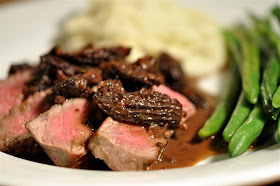
Lately FOTL has been sneaking out of his squalid, too-small digs to do a little hobnobbing. The other night I had an opportunity to try some artisan beef from small producers who treat their animals humanely and lay off excessive grain feeding.
First things first: As we learned during the evening's panel discussion, it's steer, not cow. Eat an old cow and you may not want steak ever again. Also, it's not just about the marbling. Many factors go into a good cut of beef. Try to get aged beef, either wet-aged or dry-aged. My notes from the evening suggest that the dry-aged had a stronger, more adventurous flavor, at least on this particular night.
 The tasting was an eye-opener. Just as wine varies by grape and terroir, beef varies by breed and feeding grounds. These steers munched native grasses for the most part (some were "finished" with moderate amounts of grain), yet the difference in taste and texture was considerable. One had very tender, cut-with-a-butter-knife flesh, while another was much chewier; one was reserved, almost classic in taste, while another was gamier, with a long finish and an earthy, almost fungal flavor.
The tasting was an eye-opener. Just as wine varies by grape and terroir, beef varies by breed and feeding grounds. These steers munched native grasses for the most part (some were "finished" with moderate amounts of grain), yet the difference in taste and texture was considerable. One had very tender, cut-with-a-butter-knife flesh, while another was much chewier; one was reserved, almost classic in taste, while another was gamier, with a long finish and an earthy, almost fungal flavor. Thanks to Jason Wilson, owner-chef of Crush, for his skilled presentation and remarkable intermezzos to go with the steak—and to the indomitable Traca Savagodo, aka Seattle Tall Poppy, for her gracious hosting and Gladwellian connectivity talents. In total, we tried three different cuts (sirloin, New York, rib-eye) from four different varieties, all of it delicious.
So, what did I do the very next day? Yep. Rushed right out and bought some more beef to conduct my own taste test. I was surprised—amazed, really—by the prices. Organic and grass-fed beef have recently come way down in price, at least where I shop, and are now priced competitively with the factory-farmed beef at the supermarket. I talked to the butcher about this and she said there was a concerted effort underway to challenge Big Ag. That's good news.
I bought two New York strips. One was an organic grass-fed cut from Eel River Organic Beef in Northern California ($7.99 per pound). The other was an organic cut from Country Natural Beef ($10.99 per pound). The grass-fed meat was a paler red (not a bad thing, as we learned the other night, since those deep red steaks you see in the conventional supermarket are sometimes sporting a chemically-enhanced coloring) and it didn't show as much marbling; it also cooked quicker than the other cut for some reason, and so the taste test was somewhat foiled, as was my usual kick-off-the-cowboy approach to doneness, much to Martha's delight.
Now, there is a foraging angle to all this. Every year around this time I start to get the shack nasties something terrible in anticipation of spring. One of my favorite rites of the season is the morel hunt, but for now all I can do is stare at the dried specimens in my big mason jars from previous seasons—and then grab delirious handfuls to rehydrate for Steak and Morel Sauce!

Steak with Morel Sauce
I've written about morel sauces before, here and here. Really, there's no end to what you can do with morels and steak. After making the sauce a couple times you'll realize all it takes is a little improvisational brio to whip together an elegant and very tasty sauce every time, no matter what ingredients you have lying around. On this occasion I used dried morels reconstituted in water, a splash of red wine not exceeding half a cup, beef stock, and just a touch of cream.
2 steaks
2 oz dried morels (about 2 dozen)

1 shallot, finely chopped
2-3 tbsp butter
1/2 cup red wine
1 cup beef stock
1 tsp fresh thyme, chopped
2 oz heavy cream
salt and pepper
1. Rehydrate morels in hot water, just enough to cover. (Crush a few into bits before adding water.) Salt and pepper steaks and allow to come to room temperature.
2. Pre-heat over to 250 degrees. Melt 2 tablespoons butter in skillet over medium-high eat and cook steaks, a few minutes per side according to taste. Remove to oven to keep warm.
3. Add shallots to skillet—and another tablespoon of butter if necessary. Saute a minute or two, then de-glaze with red wine. Add mushrooms and their liquid and reduce.
4. When liquid is mostly evaporated add beef stock, thyme, and a few tablespoons of heavy cream. Sauce should remain dark. Reduce and pour over steaks.
A final side-note on the artisan beef tasting: One of the most important things I've learned while circling the sun is you just have to ask. Turns out one of the ranchers in attendance (she calls herself a "grass farmer") lives on a lower stretch of one of my favorite salmon rivers. I asked her if she would accept a bottle of whiskey or a bag of mushrooms if I knocked on her farmhouse door one fall day with flyrod in hand. She said yes. That's terroir I can't wait to visit.









































